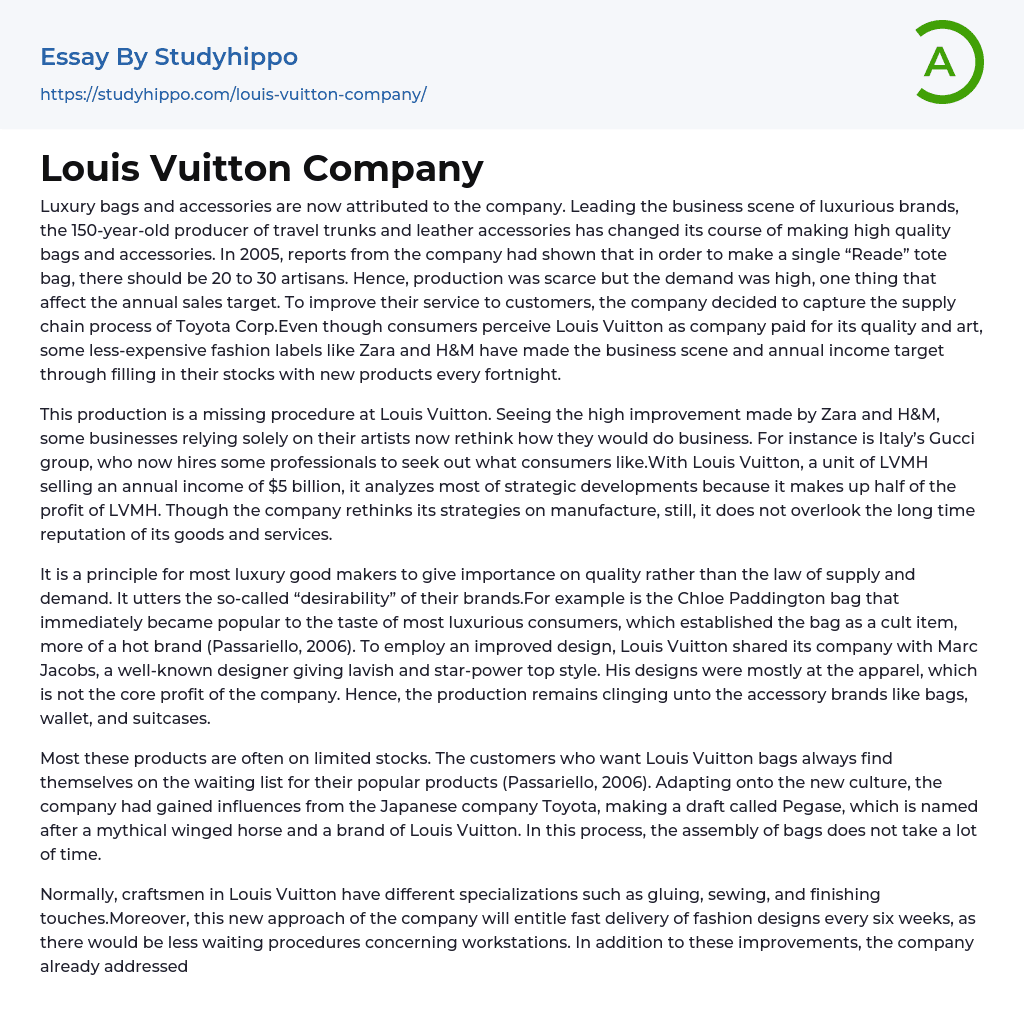The company is now recognized for its luxurious bags and accessories and is leading the market of high-end brands. For 150 years, the company produced travel trunks and leather accessories but has now shifted its focus to making high-quality bags and accessories. In 2005, the company reported that it required 20 to 30 artisans to make a single "Reade" tote bag, which limited production and affected annual sales targets. In order to meet customer demands, the company adopted Toyota Corp's supply chain process. Even though consumers associate Louis Vuitton with quality and art, other fashion labels such as Zara and H;M have achieved their annual income targets by restocking their inventory with new products every two weeks.
Louis Vuitton is realizing the importance of adapting to changing consumer preferences, as demonstrated by successful fast fashion brands like Zara and H;M. In fact, even
...the traditional Gucci group in Italy has started hiring professionals to better understand what consumers want. As LVMH's top-selling brand with $5 billion in annual revenue, Louis Vuitton is analyzing strategic developments that will maintain its half of LVMH's profits. While they are reassessing manufacturing strategies, they are committed to maintaining the high reputation of their goods and services over time.
Most luxury good makers prioritize quality over supply and demand, emphasizing the "desirability" of their brands. An example of this is the Chloe Paddington bag, which became a cult item among luxurious consumers. Louis Vuitton partnered with well-known designer, Marc Jacobs, to enhance their design and bring star-power to their apparel line while still focusing on producing accessories such as bags, wallets, and suitcases for their core profit.
Due to limited stocks, customers
seeking Louis Vuitton bags frequently end up on waiting lists for their popular products (Passariello, 2006). To integrate with a new culture, the company looked to Japanese automaker Toyota for inspiration, resulting in the creation of Pegase, an assembly process named after a mythical winged horse and a Louis Vuitton brand. This innovative process allows for quick bag assembly.
Traditionally, various craftsmen at Louis Vuitton are specialized in distinct areas such as gluing, sewing, and finishing touches. This latest approach from the company will result in quicker fashion design delivery every six weeks by minimizing waiting times at workstations. Louis Vuitton has previously addressed globalization by expanding into Japan during the 1980s, having only had a factory in Asnieres near Paris during the 1970s. The company has continuously procured factories or ateliers in France, as heightened globalization demands more.
The average expansion of Louis Vuitton used to be two factories or ateliers each year. Now, there are 13 factories solely focused on accessories. However, this still hasn't resolved the supply problem. Louis Vuitton releases a new handbag style each season, but even with manufacturers working overtime, they cannot keep up with demand when a seasonal bag becomes popular. As a result, potential customers are turned away when stores run out of stock (Passariello, 2006). Louis Vuitton was impressed by the ability of Japanese car dealers to produce and change vehicle orders quickly.
Despite being called the "zero-deficit policy," it may not be feasible for Louis Vuitton due to the nature of their factory. The facility employs 250 individuals who specialize in specific tasks such as cutting leather and canvas, preparing and sewing materials, creating pockets and linings,
and assembling bags. As a result of their specialization, it may be challenging to promote flexibility among workers, an issue highlighted by Passariello in 2006. Louis Vuitton refers to these employees as specialists.
These workers used to focus on one bag at a time, such as half-finished purses that were placed on carts and moved to another station to be completed. The specialization of artisans allowed Louis Vuitton to maintain its zero deficit policy, which was nearly impossible. To address this issue, the company enlisted the help of McKinsey. The group identified the problem: there was too much wasted time. To revamp the Pegase plan, they began by training each worker to perform three different tasks. They also divided the production process for each product into separate tasks, giving each worker more time to complete one product.
In response to the demand for increased production, Louis Vuitton reorganized their factory floor based on the team format used by Japanese electronic makers. They grouped workers into teams of 6 to 12, depending on the complexity of the task, and arranged workstations into U-clusters for maximum efficiency. Within each cluster, workers passed products from one to another. These changes primarily affected the production team and were implemented to enhance supply (Passariello, 2006).
- Wal-Mart essays
- Discover essays
- Bankruptcy essays
- Earnings essays
- Tata Group essays
- S corporation essays
- Secretary essays
- Premise essays
- Clothing essays
- Footwear essays
- Fashion design essays
- Cosmetic Surgery essays
- Jeans essays
- Advertisement essays
- Advertising essays
- Anheuser-busch essays
- Audience Theory essays
- Brand essays
- Brands essays
- Competitor Analysis essays
- Consumer essays
- Detergent essays
- Marketing Management essays
- Marketing Mix essays
- Marketing Plan essays
- Marketing Research essays
- Marketing Strategy essays
- New Product Development essays
- Point Of Sale essays
- Price essays
- Procurement essays
- Product essays
- Product Differentiation essays
- Product Placement essays
- Promotion essays
- Promotion And Marketing Communications essays
- Research Design essays
- Retailing essays
- Trademark essays
- Adidas essays
- Amazon essays
- Apple essays
- Bmw essays
- British Airways essays
- Burger King essays
- Coca-Cola essays
- Company essays
- Costco essays
- Dell essays
- Ebay essays




